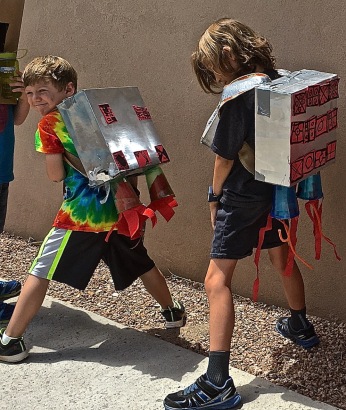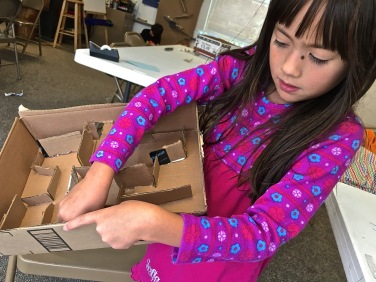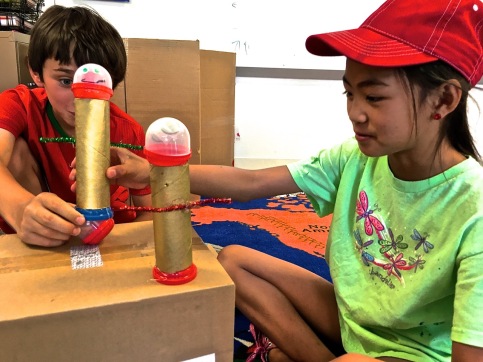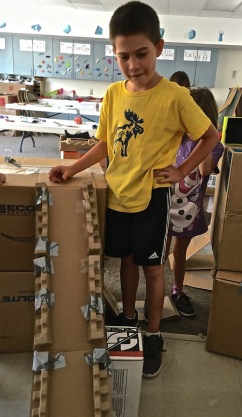Cardboard Challenges: No Tech/Low Cost Maker Education
I believe in the importance of participating in ongoing and continuous reflective practice as an educator. This is my reflection on my Cardboard Challenges Maker Education Camp that was taught to twelve 5 to 10 year old learners for five days, 2.5 hours each morning. My Cardboard Challenges webpage of ideas can be found at http://www.makereducation.com/cardboard-challenge.html.
This post is divided into three sections: (1) a rationale for using no tech, minimal cost materials, (2) some of my general observations about how the learners interacted with the materials, the projects, and each other during the camp, and (3) a description of the specific cardboard activities along with my observations how well they worked with the learners.
A Rational for Using No Tech, Minimal Cost Materials
The Cardboard Challenges Maker Education Camp utilized no technology (except for projecting images of example projects on the whiteboard) and low/no cost materials. Many of the discussions about and actions related to integrating maker education into educational environments center around the use of new technologies such computer components (Raspberry Pis, Arduinos), interactive robots for kids (Dash and Dot, Ozobots, Spheros), and 3D printers. These technologies are lots of fun and one of my maker education camps this past summer was Bots and Coding. The learners engaged in these learning activities with high excitement and motivation. Such high excitement, engagement and motivation, though, were also seen at my low tech/low cost maker education camps: LED crafts, Toy Hacking and Making, and Cardboard Challenges.
As a recent NPR article discussed several challenges for maker education. One of them was related to equity issues, providing maker education for all students regardless of income level:
A big challenge for maker education: making it not just the purview mostly of middle- and upper-middle-class white kids and white teachers whose schools can afford laser cutters, drones or 3-D printers (3 Challenges As Hands-On, DIY Culture Moves Into Schools).
In order to adequately address this challenge, it becomes important to speak of making in broader terms; that maker education is so much more than 3D printing, drones, and robots. As Adam Savage from Mythbusters notes:
What is making? It is a term for an old thing, it is a new term for an old thing. Let me be really clear, making is not simply 3D printing, Art Lino, Raspberry Pi, LEDs, robots, laser and vinyl cutters. It’s not simply carpentry and welding and sculpting and duct tape and drones. Making is also writing and dance and filmmaking and singing and photography and cosplay. Every single time you make something from you that didn’t exist in the world, you are making. Making is important; it’s empowering. It is invigorating (Adam Savage’s 2016 Bay Area Maker Faire Talk).
Doing and promoting maker experiences such as cardboard projects have the potential to offset the challenges associated with access and costs as well as provide opportunities for making by all.
General Observations from the Cardboard Challenges Maker Education Camp: How the Learners Interacted with the Materials, Projects, and Each Other
Going with Learners’ Energy and Ideas
During the making activities, I had one learner who often generated ideas for extending the projects we were doing. For example, when we made jet packs (see below), he asked for permission and made a space helmet to go with it. When we made small robots (see below), he proposed making a cardboard house for his robot. The other learners loved his ideas and joined him in these extensions of the make projects. I believe it is important to follow learners’ leads and ideas as it creates energy, motivation, and momentum for learning. Traditional teaching is way too often focused on keeping to an agenda both in time and with the learning activities. I think it is important to grab onto those teachable moments; the moments when learners propose what direction they would like to go. It validates that their voices as students are valued and acted upon.
The Experiential Nature of Maker Activities Makes Them Messy, Loud, and Chaotic
Traditional classrooms are often marked by students quietly at their desks completing the same tasks at the same time. This is opposite of what went on during the Cardboard Challenges Maker Education camp. The classroom was loud, seemingly chaotic and messy. Cutting and working with cardboard creates a mess, but authentic and engaged learning is often messy.
Learning is often a messy business. “Messy” learning is part trial and error, part waiting and waiting for something to happen, part excitement in discovery, part trying things in a very controlled, very step by step fashion, part trying anything you can think of no matter how preposterous it might seem, part excruciating frustration and part the most fun you’ll ever have. Time can seem to stand still – or seem to go by in a flash. It is not unusual at all for messy learning to be …um …messy! But the best part of messy learning is that besides staining your clothes, or the carpet, or the classroom sink in ways that are very difficult to get out … it is also difficult to get out of your memory! (http://www.learningismessy.com/quotes/)
This description marked what occurred during all of the five days of the Cardboard Challenges camp and I believe lots of learning resulted.
Concepts and Skills Naturally Embedded in the Experiential Activities
Concepts and skills became embedded in the experiential activities. Learning of concepts and skills occurred at the time when the campers’ interest and need were the highest. For example, when the learners did the cardboard garages and ramps for toy cars, several concepts were introduced and talked about: inclined plane, angles, rate of acceleration, and weight and density. These discussions and knowledge helped them to better their design their ramps. Their learning had a context and a reason.
The same was true for the the learning of skills. Learners were motivated and attentive when I demonstrated certain cardboard folding and connecting techniques. This also included soft skills such as communicating needs, asking for what they needed, and collaborating with others as they found a genuine need and desire to use them.
Shared and Collaborative Learning: Natural and As Needed
Research supports the use of collaborative and shared learning. The best kind of collaborative and shared learning, I believe, is when it occurs naturally and when needed (similar to the learning of skills as discussed above). Shared learning was evident when the learners created space helmets after one learner started his; when the youngest learner, a 5 year old girl, showed others how to use the shelf contact paper correctly (also demonstrating that learners of all ages and genders had something to contribute to the learning community). Collaborative learning happened when the learners began to individually create their car garages and ramps, and realized that if they combined their creations, they would have cooler and more elaborated structures.
Semi Structured Projects with Simple Photographic Examples Work Well
This elementary age group seemed to respond well to semi-structured cardboard projects. For all of the cardboard challenge activities, I only needed to show the learners a few examples projected on the whiteboard. From these examples, the learners gathered enough information and were able to take off to construct their own modifications of the projects. The cardboard projects became personal as the campers became self-directed learners.
Assumptions About Skill Levels
The educator needs to be an astute observer of how learners interact with instructional materials, and make adjustments if problems arise. How this translated into the cardboard challenge is that I assumed the learners could use transparent tape, hot glue guns, and scissors. I knew the younger ones, the Kindergarten students, would have some problems but didn’t expect this of the older ones, 3rd, 4th, and 5th graders. I observed the learners as they interacted with the cardboard constructing tools. I had transparent tape in the disposable plastic dispensers. Most of the campers had trouble getting it off. I realized that the heavy duty tape dispensers worked better and switched to using those. I used hot glue guns with elementary level kids for years but this group had an especially difficult time using them resulting in minor burns by 3/4 of the learners. I was forced to ban them half way through the week. I needed to change the use of hot glue to duct tape and cardboard screws from the Makedo kits. These may seem like small or inconsequential things but insuring that the learners can effectively use the tools and materials can make the difference in their success with the projects.
Cardboard Challenges: Descriptions and Reflections
This section provides brief descriptions of the activities I did during this camp and my reflections on their degree of success with the learners.
Jet Packs
Directions for constructing the jet packs can be found at http://www.kiwicrate.com/projects/Recycled-Jet-Pack-Costume/500 . I spray painted them silver prior to the camp but the kids constructed the rest of their jet packs.


Reflection:
This was a great way to start off the week. All of the learners seemed to enjoy creating them and adding their own personal touches. One of the learners, a 10 year old boy, asked if he could use another box to create a space helmet. I said, “Of course,” and the other learners began to follow their lead (which led me to spray painting the helmets during their recess). I would definitely do this activity again and would facilitate extensions of the activity such as, “Is there anything else you’d like to create to go with your jet pack?’
Marble Run
Directions for a Marble Run can be found http://lemonlimeadventures.com/recycled-marble-run/.


Reflection:
The Marble Run was another very engaging and successful activity. The learners worked on different methods and materials to make the marble run. There were lots of iterations of this project but all the learners were successful in getting their marbles to drop from tube to tube.
I would definitely do this activity again. I would add, though, sketching the marble run designs and patterns on a piece of paper and then on their large pieces of cardboards prior to adding the tubes and other obstacles. I had marbles and small balls available to test the runs but would include additional types of small balls in the future.
Marble Maze
Directions for building a version of this can be found at http://frugalfun4boys.com/2015/10/14/how-to-make-a-cardboard-box-marble-labyrinth-game/


Reflection:
This seemed to be another highly engaging activity. I would do this again in the future. I would just include more options to create the maze – e.g., construction paper, cubs, toilet paper tubes – as some of the learners had trouble managing and building the walls out of cardboard.
Cardboard Roll Robot
A version of this project can be found at http://gluesticksgumdrops.com/robot-toilet-paper-roll-craft/. I added the vending machine bubbles for use for heads and feet; and LED lights to light up the head.

Reflection:
I believe the learners found this fun but not overwhelming so. What added to this activity was a learner who asked if he could make a cardboard house for his bot with the other learners then following his lead.
This activity was okay – engaging but not highly engaging. I would do it again as an auxiliary to another activity – e.g., being the characters for a cardboard city.
Basketball Hoop/Ring Toss
I obtained boxes and figured out how to fold them to create a type of basketball arcade game and added the triangle in the front (based off of http://www.artistshelpingchildren.org/boxescardboardboxesartscraftstideasprojectskids.html). I used pool dive rings so the learners can use the ring as both a basketball hoop and a ring toss. After its completion, the learners painted their boxes with poster paint.


Reflection:
Since this was a sports – arcade type of project, I expected high interest and high engagement. The most fun, I believe, was when they painted their games. They didn’t seem to have much interest in playing the game. This also might be that this project had the least wiggle room for personalization. I will probably not include this activity for future cardboard challenges.
Parking Garages and Ramps for Toy Cars
For example directions for the cardboard parking garage, see http://frugalfun4boys.com/2015/02/03/cardboard-box-hot-wheels-car-garage-ramps/. For example directions for car ramps, see http://www.sheknows.com/parenting/articles/1023689/diy-race-car-track-crafts-for-kids.


Reflection:
The learners really jumped into this project. Anything with hot wheel type cars, I believe, are attractive for elementary students. I offered an option to build a zoo to take into account the girls and any boys who wanted such an option. Only one of the three girls at this camp selected the zoo option.
This was a very high interest and engagement activity which is what I expected. What I didn’t expect was how several of the learners ended up joining their structures to create bigger structures. I found that with projects that include buildings and other city structures, the elementary level kids naturally join them together resulting in collaborative work. This also happened during my LED craft camp.
I would definitely do this activity again. In the future, though, I would intentionally build in connecting structures together as a group.
Pinball Machines
Directions for very similar Pinball Machines can be found at http://www.instructables.com/id/Makedo-Pinball-Machine/ and http://www.artistshelpingchildren.org/kidscraftsactivitiesblog/2011/02/how-to-make-simple-pinball-machine-with-recycled-materials-crafts-project-for-kids/. To prepare for this activity, I cut the boxes as can be seen the picture below. To the plans, I added the use of shelf contact paper to cover the pinball cardboard face.


Reflection:
This was also a high engagement activity, but parts of creating the pinball machine were difficult for most of the learners, e.g., adding flippers. One of the highlights for learners, I believe, was the use of the Makedo kits. First, the screws take the place of adhesives such as hot glue, tape, etc., and second, the learners got the chance to use and learn how to use simple tools: saw, screw driver, screws. Both the kids and I loved these kits and I would use them again for the cardboard challenges.
We worked on the pinball machines for about 3 hours and only two of the learners were able to add their pinball flippers. I would do this activity again but would spend more time preparing the boxes ahead of time. I would cut the holes for the flippers, ball catchers, and as I spent a lot of time doing this during the activity. I would also plan for more time to put the finishing touches on them.

Hello Jackie
Thank you for sharing. I enjoyed reading your article and I agree that not all learning activities need to involve technology. A couple of weeks ago I gave my grandchildren a cardboard box, sticky tape and wrapping paper they spent a couple of hours totally engrossed in making a dog kennel. It was the first time I have seen all 3 children (8, 6 & 3) play “nicely” together without arguing. They were totally engrossed in the making of the kennel and their imaginary context of being a mum, dad and a dog. It was wonderful to watch them having so much fun.
Best wishes, Jenni
jennip98MU
July 27, 2016 at 3:44 am
It’s pretty amazing how providing learners with the right materials, learning naturally occurs.
Jackie Gerstein, Ed.D.
July 29, 2016 at 4:52 pm